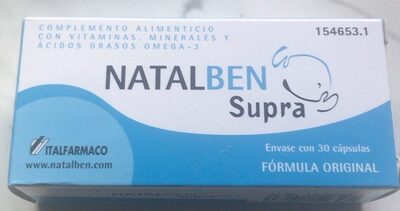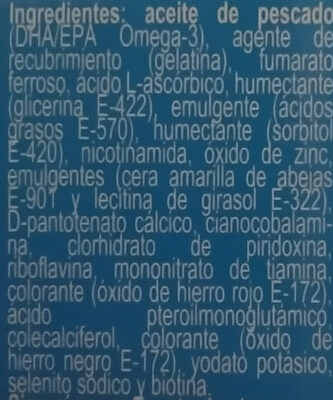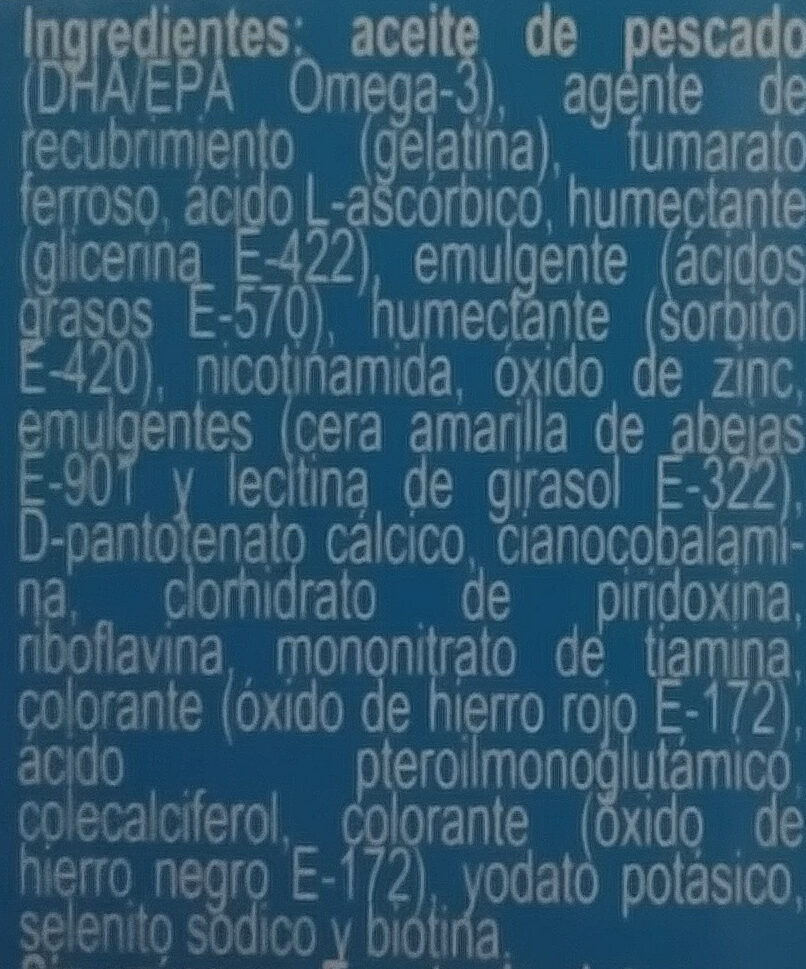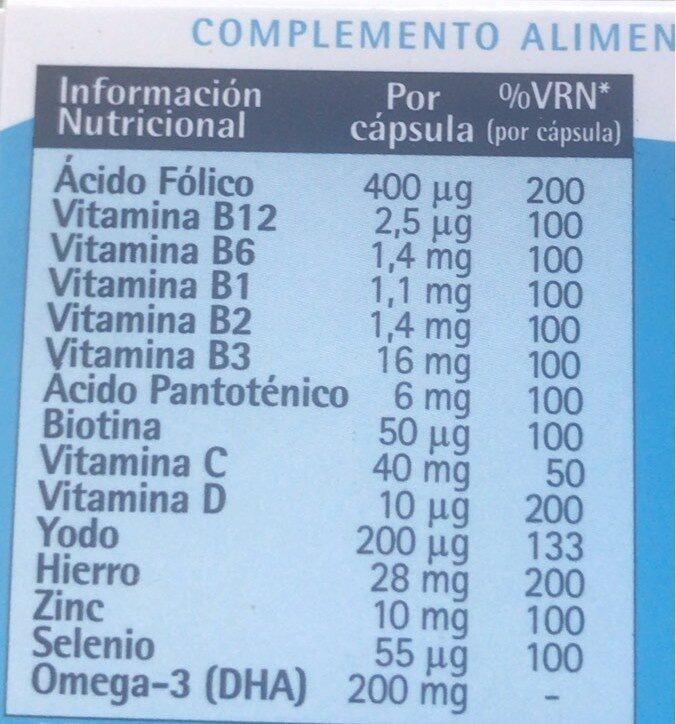Ajuda'ns a fer que la transparència alimentària sigui la norma!
Com a organització sense ànim de lucre, depenem de les vostres donacions per continuar informant els consumidors de tot el món sobre tot allò què mengen.
La revolució alimentària comença amb tu!
Natalben - Italfarmaco
Natalben - Italfarmaco
Aquesta pàgina del producte no està completa. Podeu ajudar a completar-la editant-la i afegint-hi més dades a partir de les fotos ja disponibles, o fent-ne més amb l'aplicació de androide o iPhone / iPad. Gràcies!
×
Codi de barres: 8470001546531 (EAN / EAN-13)
Marques: Italfarmaco
Categories: es:Medicina
Botigues: Farmacia
Països on es va vendre: Espanya
Matching with your preferences
Salut
Ingredients
-
27 ingredients
: aceite de pescado (DHA/EPA Omega-3), agente de recubrimiento (gelatina), ° fumarato ferroso, ácido L-ašcórbiço, humectante (glicenina E-422), emulgente (ácidos grasos E-570), 'humectante (sorbitol E-420), nicotinamida, óxido de zinc, emulgentes (cera amarilla de abejas E-901) y , lecitina de girasol E-322), D-pantotenato cálcico, cianocobalamina, clorhidrato de riboflavina, mononitrato de tiamina çolorante (óxido de hierro rojo E-172) acido çolecalciferol colorante (oxido de hierro negro E-172), yodatò potásico, selenito södico y biótinaAl·lèrgens: en:Fish
Processament d'aliments
-
Aliments ultra processats
Elements que indiquen que el producte està al grup 4 - Aliments i begudes ultraprocessats:
- Additiu: E172 - Òxids i hidròxids de ferro
- Additiu: E322 - Lecitines
- Additiu: E420 - Sorbitol
- Additiu: E428 - Gelatina
- Additiu: E901 - Cera d'abelles
- Ingredient: Emulsionant
- Ingredient: Agent de recobriment
- Ingredient: Humectant
Els productes alimentaris es classifiquen en 4 grups segons el seu grau de processament:
- Aliments no processats o mínimament processats
- Ingredients culinaris processats
- Aliments processats
- Aliments ultra processats
La determinació del grup es fa en funció de la categoria del producte i dels ingredients que conté.
Additius
-
E322 - Lecitines
Lecithin: Lecithin -UK: , US: , from the Greek lekithos, "egg yolk"- is a generic term to designate any group of yellow-brownish fatty substances occurring in animal and plant tissues, which are amphiphilic – they attract both water and fatty substances -and so are both hydrophilic and lipophilic-, and are used for smoothing food textures, dissolving powders -emulsifying-, homogenizing liquid mixtures, and repelling sticking materials.Lecithins are mixtures of glycerophospholipids including phosphatidylcholine, phosphatidylethanolamine, phosphatidylinositol, phosphatidylserine, and phosphatidic acid.Lecithin was first isolated in 1845 by the French chemist and pharmacist Theodore Gobley. In 1850, he named the phosphatidylcholine lécithine. Gobley originally isolated lecithin from egg yolk—λέκιθος lekithos is "egg yolk" in Ancient Greek—and established the complete chemical formula of phosphatidylcholine in 1874; in between, he had demonstrated the presence of lecithin in a variety of biological matters, including venous blood, in human lungs, bile, human brain tissue, fish eggs, fish roe, and chicken and sheep brain. Lecithin can easily be extracted chemically using solvents such as hexane, ethanol, acetone, petroleum ether, benzene, etc., or extraction can be done mechanically. It is usually available from sources such as soybeans, eggs, milk, marine sources, rapeseed, cottonseed, and sunflower. It has low solubility in water, but is an excellent emulsifier. In aqueous solution, its phospholipids can form either liposomes, bilayer sheets, micelles, or lamellar structures, depending on hydration and temperature. This results in a type of surfactant that usually is classified as amphipathic. Lecithin is sold as a food additive and dietary supplement. In cooking, it is sometimes used as an emulsifier and to prevent sticking, for example in nonstick cooking spray.Origen: Wikipedia (Anglès)
-
E322i - Lecitina
Lecithin: Lecithin -UK: , US: , from the Greek lekithos, "egg yolk"- is a generic term to designate any group of yellow-brownish fatty substances occurring in animal and plant tissues, which are amphiphilic – they attract both water and fatty substances -and so are both hydrophilic and lipophilic-, and are used for smoothing food textures, dissolving powders -emulsifying-, homogenizing liquid mixtures, and repelling sticking materials.Lecithins are mixtures of glycerophospholipids including phosphatidylcholine, phosphatidylethanolamine, phosphatidylinositol, phosphatidylserine, and phosphatidic acid.Lecithin was first isolated in 1845 by the French chemist and pharmacist Theodore Gobley. In 1850, he named the phosphatidylcholine lécithine. Gobley originally isolated lecithin from egg yolk—λέκιθος lekithos is "egg yolk" in Ancient Greek—and established the complete chemical formula of phosphatidylcholine in 1874; in between, he had demonstrated the presence of lecithin in a variety of biological matters, including venous blood, in human lungs, bile, human brain tissue, fish eggs, fish roe, and chicken and sheep brain. Lecithin can easily be extracted chemically using solvents such as hexane, ethanol, acetone, petroleum ether, benzene, etc., or extraction can be done mechanically. It is usually available from sources such as soybeans, eggs, milk, marine sources, rapeseed, cottonseed, and sunflower. It has low solubility in water, but is an excellent emulsifier. In aqueous solution, its phospholipids can form either liposomes, bilayer sheets, micelles, or lamellar structures, depending on hydration and temperature. This results in a type of surfactant that usually is classified as amphipathic. Lecithin is sold as a food additive and dietary supplement. In cooking, it is sometimes used as an emulsifier and to prevent sticking, for example in nonstick cooking spray.Origen: Wikipedia (Anglès)
-
E420 - Sorbitol
Sorbitol: Sorbitol --, less commonly known as glucitol --, is a sugar alcohol with a sweet taste which the human body metabolizes slowly. It can be obtained by reduction of glucose, which changes the aldehyde group to a hydroxyl group. Most sorbitol is made from corn syrup, but it is also found in nature, for example in apples, pears, peaches, and prunes. It is converted to fructose by sorbitol-6-phosphate 2-dehydrogenase. Sorbitol is an isomer of mannitol, another sugar alcohol; the two differ only in the orientation of the hydroxyl group on carbon 2. While similar, the two sugar alcohols have very different sources in nature, melting points, and uses.Origen: Wikipedia (Anglès)
-
E507 - Àcid clorhídric
Hydrochloric acid: Hydrochloric acid is a colorless inorganic chemical system with the formula H2O:HCl. Hydrochloric acid has a distinctive pungent smell. It is mainly produced as a precursor to vinyl chloride for PVC. It is classified as strongly acidic and can attack the skin over a wide composition range, since the hydrogen chloride practically dissociates completely in solution. Hydrochloric acid is the simplest chlorine-based acid system containing water. It consists of hydrogen chloride and water, and a variety of other chemical species, including hydronium and chloride ions. It is an important chemical reagent and industrial chemical, used primarily in the production of polyvinyl chloride for plastic. In households, diluted hydrochloric acid is often used as a descaling agent. In the food industry, hydrochloric acid used as a food additive and in the production of gelatin. Hydrochloric acid is also used in leather processing. Hydrochloric acid was discovered by the alchemist Jabir ibn Hayyan around the year 800 AD. Hydrochloric acid was historically called acidum salis, muriatic acid, and spirits of salt because it was produced from rock salt and "green vitriol" -IronII sulfate- -by Basilius Valentinus in the 15th century- and later from the chemically similar common salt and sulfuric acid -by Johann Rudolph Glauber in the 17th century-. Free hydrochloric acid was first formally described in the 16th century by Libavius. Later, it was used by chemists such as Glauber, Priestley, and Davy in their scientific research. Unless pressurized or cooled, hydrochloric acid will turn into a gas if there is around 60% or less of water. Hydrochloric acid is also known as hydronium chloride.Origen: Wikipedia (Anglès)
-
E570 - Àcid gras
Fatty acid: In chemistry, particularly in biochemistry, a fatty acid is a carboxylic acid with a long aliphatic chain, which is either saturated or unsaturated. Most naturally occurring fatty acids have an unbranched chain of an even number of carbon atoms, from 4 to 28. Fatty acids are usually not found per se in organisms, but instead as three main classes of esters: triglycerides, phospholipids, and cholesterol esters. In any of these forms, fatty acids are both important dietary sources of fuel for animals and they are important structural components for cells.Origen: Wikipedia (Anglès)
-
E901 - Cera d'abelles
Beeswax: Beeswax -cera alba- is a natural wax produced by honey bees of the genus Apis. The wax is formed into "scales" by eight wax-producing glands in the abdominal segments of worker bees, which discard it in or at the hive. The hive workers collect and use it to form cells for honey storage and larval and pupal protection within the beehive. Chemically, beeswax consists mainly of esters of fatty acids and various long-chain alcohols. Beeswax has long-standing applications in human food and flavoring. For example, it is used as a glazing agent or as a light/heat source. It is edible, in the sense of having similar negligible toxicity to plant waxes, and is approved for food use in most countries and the European Union under the E number E901. However, the wax monoesters in beeswax are poorly hydrolysed in the guts of humans and other mammals, so they have insignificant nutritional value. Some birds, such as honeyguides, can digest beeswax. Beeswax is the main diet of wax moth larvae.Origen: Wikipedia (Anglès)
Anàlisi dels ingredients
-
Es desconeix si conté oli de palma
Ingredients no reconeguts: es:dha, es:epa-omega-3, es:acido-l-ašcorbico, es:glicenina-e422, es:lecitina-de-girasol-e322, es:clorhidrato-de-riboflavina, es:mononitrato-de-tiamina-colorante, es:oxido-de-hierro-rojo-e172, es:acido-colecalciferol-colorante, es:oxido-de-hierro-negro-e172, es:selenito-sodico-y-biotinaAlguns ingredients no s'han pogut reconèixer.
Necessitem la teva ajuda!
Podeu ajudar-nos a reconèixer més ingredients i analitzar millor la llista d'ingredients d'aquest producte i d'altres mitjançant:
- Editeu aquesta pàgina de producte per corregir les faltes d’ortografia de la llista d’ingredients i/o per eliminar els ingredients d’altres idiomes i frases que no estiguin relacionades amb els ingredients.
- Afegiu entrades, sinònims o traduccions noves a les nostres llistes multilingües d’ingredients, mètodes de processament d’ingredients i etiquetes.
Uniu-vos al canal #ingredients del nostre espai de discussió a Slack i/o apreneu sobre l'anàlisi dels ingredients en la nostra wiki, si voleu ajudar. Gràcies!
-
No és vegà
Ingredients no vegans: en:Fish oil, E428, E901Alguns ingredients no s'han pogut reconèixer.
Necessitem la teva ajuda!
Podeu ajudar-nos a reconèixer més ingredients i analitzar millor la llista d'ingredients d'aquest producte i d'altres mitjançant:
- Editeu aquesta pàgina de producte per corregir les faltes d’ortografia de la llista d’ingredients i/o per eliminar els ingredients d’altres idiomes i frases que no estiguin relacionades amb els ingredients.
- Afegiu entrades, sinònims o traduccions noves a les nostres llistes multilingües d’ingredients, mètodes de processament d’ingredients i etiquetes.
Uniu-vos al canal #ingredients del nostre espai de discussió a Slack i/o apreneu sobre l'anàlisi dels ingredients en la nostra wiki, si voleu ajudar. Gràcies!
-
No és vegetarià
Ingredients no vegetarians: en:Fish oil, E428Alguns ingredients no s'han pogut reconèixer.
Necessitem la teva ajuda!
Podeu ajudar-nos a reconèixer més ingredients i analitzar millor la llista d'ingredients d'aquest producte i d'altres mitjançant:
- Editeu aquesta pàgina de producte per corregir les faltes d’ortografia de la llista d’ingredients i/o per eliminar els ingredients d’altres idiomes i frases que no estiguin relacionades amb els ingredients.
- Afegiu entrades, sinònims o traduccions noves a les nostres llistes multilingües d’ingredients, mètodes de processament d’ingredients i etiquetes.
Uniu-vos al canal #ingredients del nostre espai de discussió a Slack i/o apreneu sobre l'anàlisi dels ingredients en la nostra wiki, si voleu ajudar. Gràcies!
-
Detalls de l'anàlisi dels ingredients
Necessitem la teva ajuda!
Alguns ingredients no s'han pogut reconèixer.
Necessitem la teva ajuda!
Podeu ajudar-nos a reconèixer més ingredients i analitzar millor la llista d'ingredients d'aquest producte i d'altres mitjançant:
- Editeu aquesta pàgina de producte per corregir les faltes d’ortografia de la llista d’ingredients i/o per eliminar els ingredients d’altres idiomes i frases que no estiguin relacionades amb els ingredients.
- Afegiu entrades, sinònims o traduccions noves a les nostres llistes multilingües d’ingredients, mètodes de processament d’ingredients i etiquetes.
Uniu-vos al canal #ingredients del nostre espai de discussió a Slack i/o apreneu sobre l'anàlisi dels ingredients en la nostra wiki, si voleu ajudar. Gràcies!
: aceite de pescado (DHA, EPA Omega-3), agente de recubrimiento (gelatina), ° fumarato ferroso, ácido L-ašcórbiço, humectante (glicenina e422), emulgente (ácidos grasos e570), humectante (sorbitol e420), nicotinamida, óxido de zinc, emulgentes (cera amarilla de abejas e901), lecitina de girasol e322, D-pantotenato cálcico, cianocobalamina, clorhidrato de riboflavina, mononitrato de tiamina çolorante (óxido de hierro rojo e172), acido çolecalciferol colorante (oxido de hierro negro e172), yodatò potásico, selenito södico y biótina- aceite de pescado -> en:fish-oil - vegan: no - vegetarian: no - from_palm_oil: no - percent_min: 5.55555555555556 - percent_max: 100
- DHA -> es:dha - percent_min: 2.77777777777778 - percent_max: 100
- EPA Omega-3 -> es:epa-omega-3 - percent_min: 0 - percent_max: 50
- agente de recubrimiento -> en:glazing-agent - percent_min: 0 - percent_max: 50
- gelatina -> en:e428 - vegan: no - vegetarian: no - percent_min: 0 - percent_max: 50
- ° fumarato ferroso -> en:iron-fumarate - percent_min: 0 - percent_max: 33.3333333333333
- ácido L-ašcórbiço -> es:acido-l-ašcorbico - percent_min: 0 - percent_max: 25
- humectante -> en:humectant - percent_min: 0 - percent_max: 20
- glicenina e422 -> es:glicenina-e422 - percent_min: 0 - percent_max: 20
- emulgente -> en:emulsifier - percent_min: 0 - percent_max: 16.6666666666667
- ácidos grasos e570 -> en:e570 - vegan: maybe - vegetarian: maybe - percent_min: 0 - percent_max: 16.6666666666667
- humectante -> en:humectant - percent_min: 0 - percent_max: 14.2857142857143
- sorbitol e420 -> en:e420 - vegan: yes - vegetarian: yes - percent_min: 0 - percent_max: 14.2857142857143
- nicotinamida -> en:e375 - vegan: maybe - vegetarian: maybe - percent_min: 0 - percent_max: 12.5
- óxido de zinc -> en:zinc-oxide - percent_min: 0 - percent_max: 11.1111111111111
- emulgentes -> en:emulsifier - percent_min: 0 - percent_max: 10
- cera amarilla de abejas e901 -> en:e901 - vegan: no - vegetarian: yes - percent_min: 0 - percent_max: 10
- lecitina de girasol e322 -> es:lecitina-de-girasol-e322 - percent_min: 0 - percent_max: 9.09090909090909
- D-pantotenato cálcico -> en:d-pantothenate-calcium - vegan: yes - vegetarian: yes - percent_min: 0 - percent_max: 8.33333333333333
- cianocobalamina -> en:cyanocobalamin - percent_min: 0 - percent_max: 7.69230769230769
- clorhidrato de riboflavina -> es:clorhidrato-de-riboflavina - percent_min: 0 - percent_max: 7.14285714285714
- mononitrato de tiamina çolorante -> es:mononitrato-de-tiamina-colorante - percent_min: 0 - percent_max: 6.66666666666667
- óxido de hierro rojo e172 -> es:oxido-de-hierro-rojo-e172 - percent_min: 0 - percent_max: 6.66666666666667
- acido çolecalciferol colorante -> es:acido-colecalciferol-colorante - percent_min: 0 - percent_max: 6.25
- oxido de hierro negro e172 -> es:oxido-de-hierro-negro-e172 - percent_min: 0 - percent_max: 6.25
- yodatò potásico -> en:e917 - vegan: yes - vegetarian: yes - percent_min: 0 - percent_max: 5.88235294117647
- selenito södico y biótina -> es:selenito-sodico-y-biotina - percent_min: 0 - percent_max: 5.55555555555556
Nutrició
-
Qualitat nutricional mitjana
⚠ ️Atenció: la quantitat de fruita, verdura i fruits secs no s'especifica a l'etiqueta, s'ha fet una estimació a partir de la llista d'ingredients: 0Aquest producte no es considera una beguda per al càlcul de la Nutri-Score.
Punts positius: 0
- Proteïnes: 0 / 5 (valor: 0, valor arrodonit: 0)
- Fibra: 0 / 5 (valor: 0, valor arrodonit: 0)
- Fruites, verdures, fruits secs i olis de colza/nou/oliva: 0 / 5 (valor: 0, valor arrodonit: 0)
Punts negatius: 10
- Energia: 0 / 10 (valor: 0, valor arrodonit: 0)
- Sucres: 0 / 10 (valor: 0, valor arrodonit: 0)
- Greixos saturats: 0 / 10 (valor: 0, valor arrodonit: 0)
- Sodi: 10 / 10 (valor: 1200, valor arrodonit: 1200)
Els punts per proteïnes es compten perquè els punts negatius són inferiors a 11.
Puntuació nutricional: (10 - 0)
Nutri-Score:
-
Nivells de nutrients
-
Greix en baixa quantitat (0%)
Què us cal saber- Un alt consum de greixos, especialment de greixos saturats, pot augmentar el colesterol, que augmenta el risc de patir malalties del cor.
Recomanació: Reduïu el consum de greixos i greixos saturats- Trieu productes amb menys greixos i greixos saturats.
-
Àcid gras saturat en baixa quantitat (0%)
Què us cal saber- Un alt consum de greixos, especialment de greixos saturats, pot augmentar el colesterol, que augmenta el risc de patir malalties del cor.
Recomanació: Reduïu el consum de greixos i greixos saturats- Trieu productes amb menys greixos i greixos saturats.
-
Sucre en baixa quantitat (0%)
Què us cal saber- Un alt consum de sucre pot provocar augment de pes i càries dental. També augmenta el risc de patir diabetis tipus 2 i malalties cardiovasculars.
Recomanació: Limitau el consum de sucre i de begudes ensucrades- Les begudes ensucrades (com ara refrescos, begudes de fruites i sucs i nèctars de fruites) s'han de limitar tant com sigui possible (no més d'1 got al dia).
- Triau productes amb menor contingut de sucre i reduïu el consum de productes amb sucres afegits.
-
Sal comuna en alta quantitat (3%)
Què us cal saber- Un alt consum de sal (o sodi) pot provocar un augment de la pressió arterial, que pot augmentar el risc de patir malalties del cor i ictus.
- Moltes persones que tenen hipertensió no ho saben, ja que sovint no en tenen símptomes.
- La majoria de la gent consumeix massa sal (de 9 a 12 grams de mitjana al dia), al voltant del doble del nivell màxim d'ingesta recomanat.
Recomanació: Limitau la ingesta de sal i d'aliments rics en sal- Reduïu la sal que emprau quan cuinau, i no afegiu sal a taula.
- Limiteu el consum d'aperitius salats i trieu productes amb menor contingut de sal.
-
-
Informació nutricional
Informació nutricional Com es ven
per 100 g/100 mlEnergia 0 kj
(0 kcal)Greix 0 g Àcid gras saturat 0 g Hidrats de carboni 0 g Sucre 0 g Fiber 0 g Proteïna 0 g Sal comuna 3 g Fruits‚ vegetables‚ nuts and rapeseed‚ walnut and olive oils (estimate from ingredients list analysis) 0 %
Entorn
-
Puntuació ecològica no calculada - Impacte ambiental desconegut
No hem pogut calcular l'Eco-Score d'aquest producte perquè li falten algunes dades, podríeu ajudar-nos a completar-lo?Podries afegir una categoria del producte més precisa perquè puguem calcular l'Eco-Score? Afegir una categoria
Empaquetament
-
Falta informació sobre l'embalatge d'aquest producte
⚠ ️ La informació sobre l'embalatge d'aquest producte no està completada.Take a photo of the recycling information Take a photo of the recycling information
Transport
-
Orígens dels ingredients
Falta informació sobre l'origen dels ingredients
⚠ ️ L'origen dels ingredients d'aquest producte no està indicat.
Si estan indicats a l'embalatge, podeu modificar la fitxa del producte i afegir-los.
Si sou el fabricant d'aquest producte, podeu enviar-nos la informació amb la nostra plataforma gratuïta per a productors.Add the origins of ingredients for this product Add the origins of ingredients for this product
Report a problem
-
Incomplete or incorrect information?
Category, labels, ingredients, allergens, nutritional information, photos etc.
If the information does not match the information on the packaging, please complete or correct it. Open Food Facts is a collaborative database, and every contribution is useful for all.
Fonts de dades
Producte afegit per kiliweb
Última modificació de la pàgina del producte per kiliweb.
La pàgina del producte, també editada per acuario, inf, nivo, thaialagata, yuka.ZEswWUhmUlptL1FzeDlvbHdocjNvTnR4OXBDSlFYdXZBY2toSVE9PQ, yuka.sY2b0xO6T85zoF3NwEKvlhAWU8LU_D_7EQfWqROV94e8JcO3Tfptv5PZKKs, yuka.sY2b0xO6T85zoF3NwEKvlmVrCf-EkCnjJQLjk2eF4vS8C83VW_1s6ZGjLKg.










